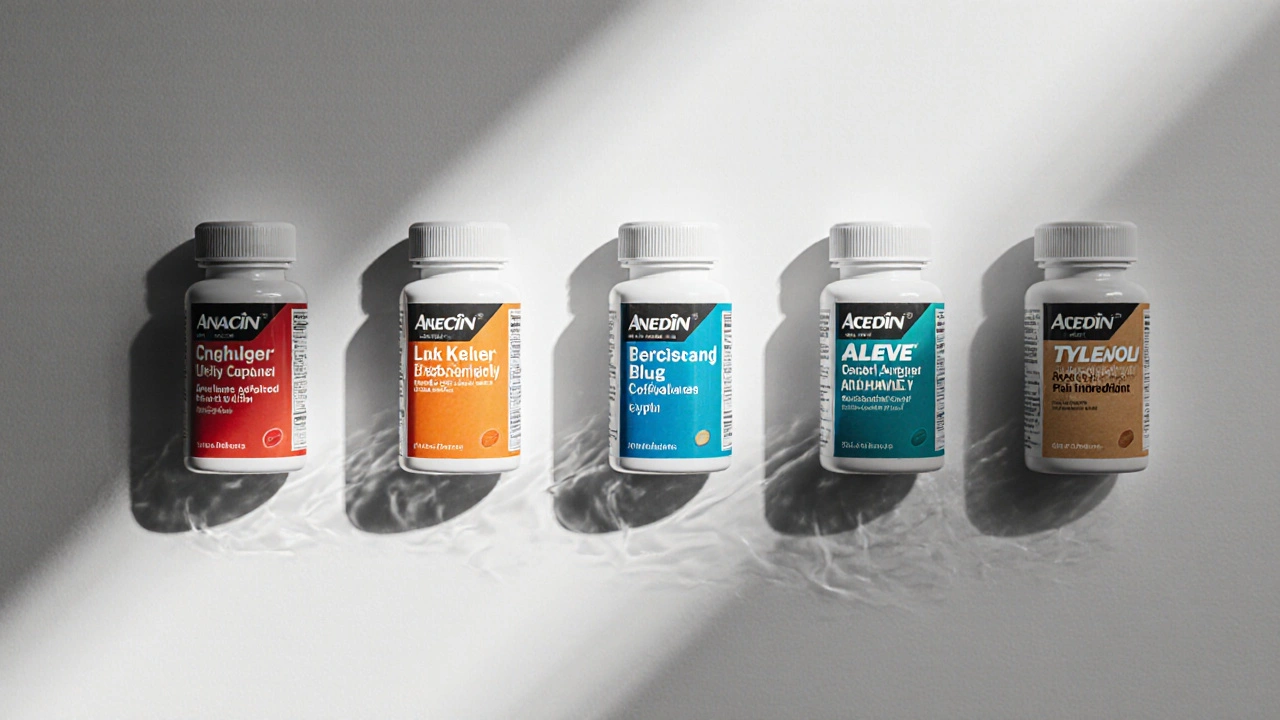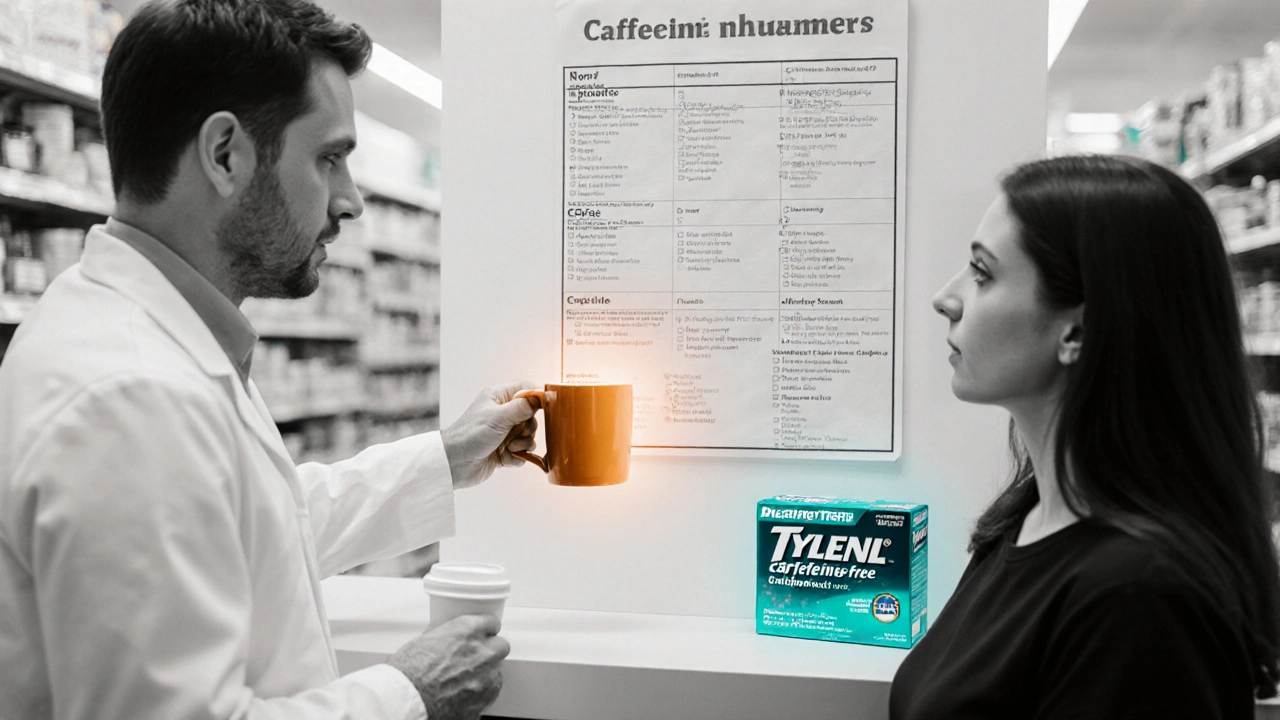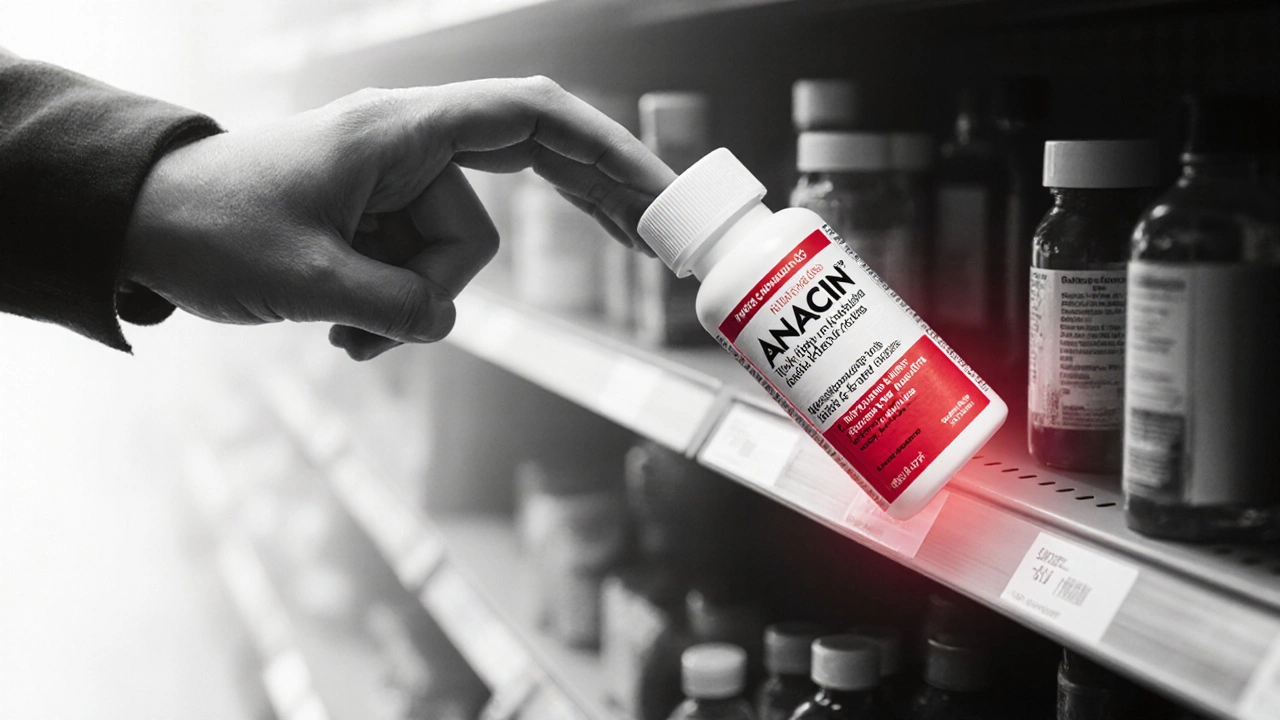Pain Relief Selector
Find Your Best Pain Reliever
Answer a few questions to get a personalized recommendation for over-the-counter pain relief.
Key Takeaways
- Anacin pairs aspirin with caffeine for fast headache relief, but its caffeine can cause jittery side effects.
- Excedrin offers a similar aspirin‑caffeine combo and adds acetaminophen for broader pain coverage.
- Advil and Aleve use ibuprofen or naproxen, delivering stronger anti‑inflammatory action without caffeine.
- Tylenol (acetaminophen) is caffeine‑free, ideal for people who can’t tolerate stimulants.
- Choosing the right product depends on your pain type, caffeine sensitivity, and any existing health conditions.
When a pounding headache hits, most of us reach for the nearest bottle on the shelf. Anacin is a classic over‑the‑counter (OTC) option that mixes aspirin and caffeine. It promises quick relief, but the market is crowded with other combos and single‑ingredient pills. This guide breaks down how Anacin stacks up against the most common alternatives, helping you pick the right tablet for your specific need.
What Makes Anacin Unique?
At its core, Anacin combines two well‑known compounds:
- Aspirin - a non‑steroidal anti‑inflammatory drug (NSAID) that blocks pain‑signaling enzymes.
- Caffeine - a mild stimulant that narrows blood vessels and speeds up aspirin’s absorption.
The synergy means you often feel relief within 15‑30 minutes, faster than aspirin alone. However, caffeine also brings potential downsides: increased heart rate, insomnia, or stomach irritation, especially if you’re sensitive or already consuming coffee.
Major Alternatives at a Glance
Below is a quick snapshot of the most popular OTC rivals. Each one targets a slightly different pain profile, and most avoid caffeine.
| Product | Active Ingredient(s) | Typical Dose | Onset | Duration | Main Use | Key Side Effects |
|---|---|---|---|---|---|---|
| Anacin | Aspirin 325mg + Caffeine 30mg | 1-2 tablets | 15‑30min | 4‑6h | Headache, tension‑type pain | Stomach upset, jitteriness |
| Excedrin | Aspirin 250mg + Acetaminophen 250mg + Caffeine 65mg | 2 tablets | 15‑30min | 4‑6h | Migraine, moderate headache | Rebound headache, stomach irritation |
| Advil | Ibuprofen 200mg | 1-2 tablets | 30‑60min | 6‑8h | Muscle aches, inflammation | GI upset, kidney strain |
| Aleve | Naproxen sodium 220mg | 1 tablet | 30‑60min | 8‑12h | Joint pain, arthritis | Stomach bleeding, cardiovascular risk |
| Tylenol | Acetaminophen 500mg | 1 tablet | 30‑45min | 4‑6h | Fever, mild headache | Liver toxicity (overdose) |
Decision Criteria - How to Pick the Right Pill
Not every pain reliever suits every person. Use the checklist below to match your situation with the best option.
- Caffeine tolerance - If coffee makes you nervous, skip caffeine‑based combos.
- Inflammation level - Swollen joints respond better to ibuprofen or naproxen.
- Liver vs. stomach health - Acetaminophen is gentle on the stomach but hard on the liver; aspirin can irritate the gut.
- Frequency of use - For daily chronic pain, a longer‑acting NSAID like naproxen is safer than repeated caffeine spikes.
- Age and comorbidities - Seniors and people with heart disease should avoid high‑dose aspirin and caffeine.

Deep Dive: When Anacin Shines
If you’re dealing with a sudden tension‑type headache that’s triggered by stress or lack of sleep, Anacin’s rapid onset can be a lifesaver. The caffeine component contracts blood vessels in the brain, which often relieves that pulsing pressure faster than aspirin alone.
Best scenarios for Anacin:
- Acute, short‑lived headaches (< 4hours).
- When you already consume a modest amount of caffeine (e.g., one cup of coffee) and don’t mind the extra boost.
- When you don’t have a history of stomach ulcers or bleeding disorders.
Things to watch out for:
- Repeated use can lead to rebound headaches.
- Combining with other caffeine sources may cause insomnia or heart palpitations.
- Not ideal for children under 12 without physician guidance.
When to Reach for an Alternative
Let’s walk through a few common pain profiles and the most suitable OTC pick.
| Pain Situation | Top Choice | Why |
|---|---|---|
| Migraine with nausea | Excedrin | Adds acetaminophen for extra pain relief; caffeine helps with nausea‑induced blood‑vessel changes. |
| Joint inflammation (arthritis) | Aleve | Long‑acting naproxen reduces swelling for up to 12hours. |
| Muscle soreness after workout | Advil | Ibuprofen’s anti‑inflammatory effect targets muscle tissue without caffeine. |
| Fever or mild headache, caffeine‑sensitive | Tylenol | Acetaminophen eases pain without irritating the stomach or stimulating the nervous system. |
| Frequent low‑grade headaches, want no caffeine | Low‑dose aspirin (325mg) alone | Provides basic NSAID action without caffeine’s side effects. |
Potential Pitfalls & How to Avoid Them
Even common OTC medicines can trip you up if you ignore warnings.
- Double‑dipping on caffeine - Always check other meds (e.g., cold remedies) for hidden caffeine.
- Stacking NSAIDs - Avoid taking ibuprofen plus aspirin together; it raises bleeding risk.
- Alcohol interactions - Mixing any NSAID with alcohol can damage the stomach lining.
- Kidney concerns - Chronic ibuprofen or naproxen use can strain kidneys, especially in older adults.
When in doubt, read the label, stick to the recommended dose, and consider a brief chat with a pharmacist.

Quick Reference Cheat Sheet
- Anacin - Best for fast, caffeine‑enhanced headache relief.
- Excedrin - Migraine‑focused, adds acetaminophen.
- Advil - General pain & inflammation, no caffeine.
- Aleve - Long‑lasting joint pain, strong anti‑inflammatory.
- Tylenol - Fever & mild pain, safe for caffeine‑sensitive users.
Frequently Asked Questions
Can I take Anacin with my morning coffee?
Yes, but keep total caffeine under about 200mg (roughly one cup of coffee). Too much caffeine can cause jitteriness, insomnia, or increased heart rate.
Is Anacin safe for children?
The FDA advises against giving aspirin‑containing products to children under 12 without a doctor’s order because of the risk of Reye’s syndrome. For kids, acetaminophen or ibuprofen (approved dosage) is usually preferred.
How does caffeine boost aspirin’s effect?
Caffeine narrows blood vessels and speeds the absorption of aspirin into the bloodstream, which shortens the time it takes to feel relief.
Should I avoid NSAIDs if I have high blood pressure?
Yes, long‑term use of NSAIDs (including aspirin, ibuprofen, naproxen) can raise blood pressure. Talk to your doctor about safer alternatives like acetaminophen.
What’s the best OTC choice for a migraine that lasts 8‑10hours?
Excedrin is often recommended because it combines aspirin, caffeine, and acetaminophen, covering multiple pain pathways. If you can’t handle caffeine, a prescription triptan might be necessary.
Next Steps - How to Choose Wisely
1. Identify your primary symptom (headache, joint pain, fever).
2. Check your caffeine tolerance and any stomach or heart conditions.
3. Match the symptom to the table above - pick the product that aligns with your health profile.
4. Stick to the label dosage. If you need more than one dose in 24hours, consider a non‑caffeine alternative to avoid buildup.
5. If you’re unsure, a quick call to a pharmacist can confirm the safest option.
By understanding how Anacin’s aspirin‑caffeine combo works and where other OTCs excel, you can stop guessing and start treating pain with confidence.







Steven Waller
October 15, 2025 AT 12:23When you think about pain relief it's useful to match the mechanism of the drug to the nature of the discomfort. Anacin’s caffeine‑aspirin combo works best for tension‑type headaches because the stimulant narrows cerebral vessels quickly. If inflammation is the main issue, ibuprofen or naproxen generally provide more lasting relief. For people who are sensitive to caffeine, a plain aspirin or acetaminophen avoids the jittery side effects. Always check the label for dosing limits, especially if you combine multiple OTC products.
Puspendra Dubey
October 15, 2025 AT 14:36Yo, the whole caffeine‑aspirin vibe is like a cosmic dance of chemistry, ya feel me? It’s like the universe gave us a shortcut to shake off those throbbing vibes, but then you end up wired like a hamster on a wheel. ð If you’re already guzzling java, you might just crash harder than a busted server.
Shaquel Jackson
October 15, 2025 AT 16:50Honestly, I’d just take a nap and let the headache fade.
Tom Bon
October 15, 2025 AT 19:03In a clinical sense, choosing an analgesic should consider both pharmacodynamics and patient comorbidities. The presence of caffeine in Anacin may exacerbate hypertension, whereas NSAIDs like ibuprofen can affect renal function. For patients with a history of peptic ulcer disease, a proton‑pump inhibitor co‑prescribed with an NSAID could mitigate risk. Conversely, acetaminophen remains a safe alternative for those avoiding gastric irritation, provided hepatic limits are observed. Ultimately, a personalized approach yields the most effective and safest outcome.
Clara Walker
October 15, 2025 AT 21:16What they don’t tell you is that the pharma giants are pushing caffeine combos to keep us dependent on the stimulant culture. The subtle push toward jittery mornings keeps the consumer market buzzing, literally. And the fact that they hide the long‑term cardiovascular risks under a “headache” label is nothing short of a coordinated agenda. Keep your eyes open, read the fine print, and don’t let the corporate narrative dictate your health choices.
Jana Winter
October 15, 2025 AT 23:30While the article is thorough, there are several grammatical oversights that merit attention. For instance, “caffeine can cause jittery side effects” should read “caffeine can cause jittery side effects.” Also, the phrase “a brief chat with a pharmacist” could be refined to “a brief consultation with a pharmacist.” Precision in language mirrors precision in dosage.
Linda Lavender
October 16, 2025 AT 01:43One must contemplate, with a measured yet expansive gaze, the ontological implications of selecting a pharmacologic agent for the alleviation of transient somatic disquiet. The dichotomy presented by Anacin, wherein caffeine and aspirin coalesce, is not merely a matter of biochemical synergy but a reflection of our cultural predilection for immediacy. When the throbbing of a tension‑type cephalgia assaults the mind, the rapid absorption facilitated by caffeine offers a temporal reprieve that aligns with the modernist’s yearning for swift resolution. Yet, this very expediency bears the subtle cost of physiological perturbation; the cardiovascular system, ever susceptible to catecholaminergic surges, may respond with an untoward tachycardia or heightened arterial pressure, especially in individuals whose homeostatic set‑points are already precariously balanced. In contrast, the indolent yet potent anti‑inflammatory action of ibuprofen or naproxen, as embodied by Advil and Aleve respectively, signifies a deliberative approach, one that eschews fleeting comfort for sustained amelioration of inflammatory cascades. The pharmacokinetic latency inherent to these agents-onset spanning thirty to sixty minutes-mirrors the philosophical patience advocated by the Stoics, who counsel acceptance of the natural tempo of corporeal healing. Moreover, the omission of caffeine from these formulations eliminates the risk of nocturnal insomnia, an affliction that, if unmitigated, can precipitate a cascade of neurocognitive deficits, undermining the very productivity that prompts the initial recourse to analgesia. The alternative, Tylenol, furnishes an analgesic devoid of gastrointestinal irritants yet imposes an inexorable specter of hepatotoxicity, a risk magnified in the context of polypharmacy or inadvertent over‑dosage. Consequently, the physician-or indeed the lay individual-must navigate a labyrinthine decision matrix, balancing analgesic potency, inflammatory suppression, organ system vulnerability, and the psychosocial dimensions of caffeine consumption. Importantly, the recurrent utilization of Anacin may engender a refractory cycle of rebound headaches, an iatrogenic phenomenon wherein the very instrument of relief becomes a progenitor of chronic discomfort. Hence, a judicious rotation of therapeutic agents, interspersed with non‑pharmacologic modalities such as ergonomic adjustments, hydration, and stress‑reduction techniques, constitutes a holistic strategy. In summation, while Anacin’s rapidity may render it alluring for the acute, exigent practitioner, the discerning user must remain vigilant to its systemic reverberations, privileging a tailored regimen that harmonizes immediate efficacy with long‑term physiological integrity.
Jay Ram
October 16, 2025 AT 03:56Bottom line: if you need a quick pick‑me‑up for a sudden headache, Anacin does the job, but don’t make it a habit. For sore muscles after the gym, reach for Advil and keep that caffeine for your morning coffee.
Elizabeth Nicole
October 16, 2025 AT 06:10Curious about how caffeine actually speeds up aspirin absorption? It constricts cerebral blood vessels, creating a concentration gradient that drives the drug into the bloodstream faster. That’s why you feel relief sooner, but it also means you might feel the jitter if you’re already caffeinated.
Dany Devos
October 16, 2025 AT 08:23From a professional standpoint, the article’s comparative table is well‑structured, yet it could benefit from including dosage limits for children and pregnant individuals. Additionally, a brief note on contraindications for patients on anticoagulant therapy would enhance its clinical utility.
Sam Matache
October 16, 2025 AT 10:36Let’s be real – most people just grab whatever’s on the nearest shelf without reading the fine print. The drama around “caffeine side effects” is blown out of proportion; most folks can handle a single cup of coffee plus Anacin without a catastrophe. Still, the pharma marketing machine loves to hype the “fast‑acting” angle to keep sales high.
Hardy D6000
October 16, 2025 AT 12:50While the narrative pushes caffeine as a benign booster, the reality is that chronic intake can exacerbate hypertension, especially when combined with other stimulants. It’s a subtle form of engineered dependence, ensuring consumers stay locked into a cycle of “need and relief.”
Crystal McLellan
October 16, 2025 AT 15:03caffeine + aspirin = more jitter not good